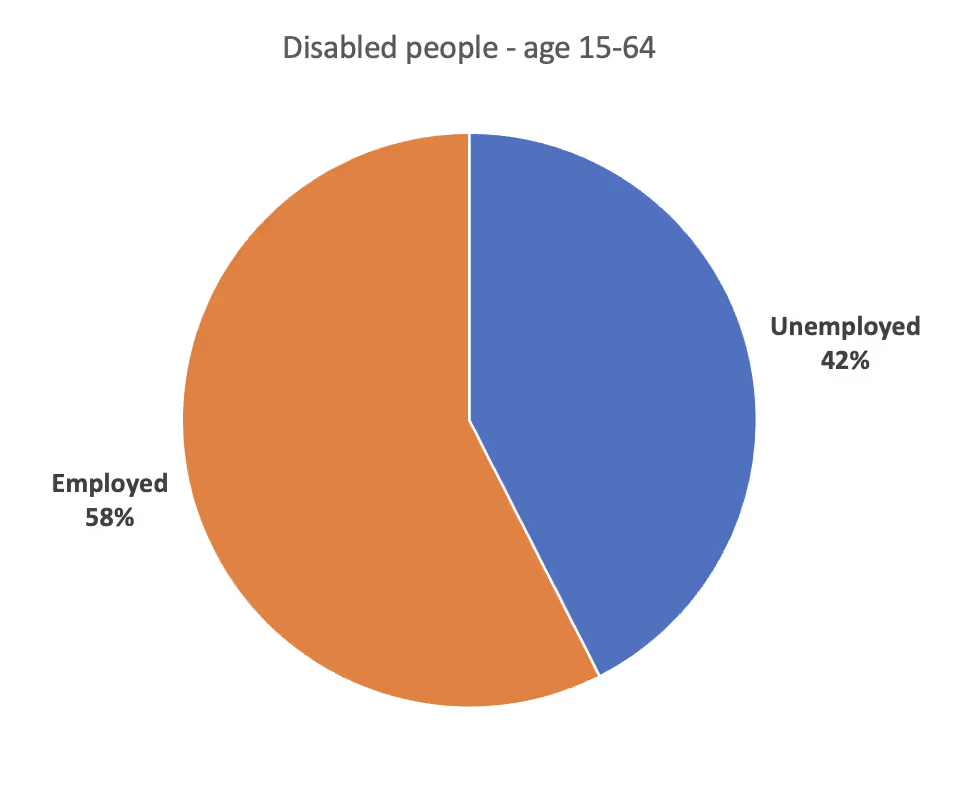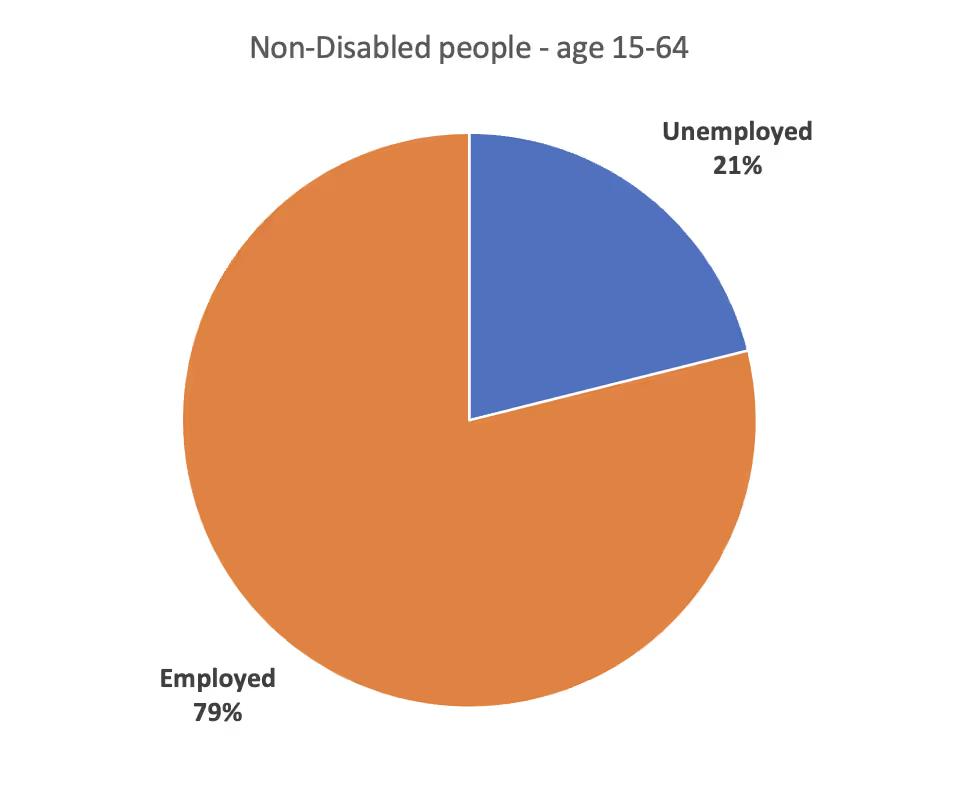The Ultimate Guide to Accessibility for Tāngata Whaikaha

As the world has changed there has been greater awareness and drive for diversity within workplaces - but a large section of the population's needs are still being regularly ignored.
* Ngā Whaikaha - People who have strength, to have ability, to be otherly abled, and to be enabled.

Tāngata Whaikaha* - or people with disabilities - continue to be some of the most underrepresented people in employment, and are often forgotten in an organisation’s drive for greater Diversity and Inclusion
This group accounts for around 25 percent of Aotearoa’s population, and they are less likely to be employed than people without disabilities or other minorities. (Employment for disabled people). Even when employed, the discrimination and accessibility issues still prove detrimental to their health and career progression.
It’s a group that I find myself in. Throughout my own working career, I have faced numerous amounts of bullying and discrimination related to my disability. From the rather innocuous to severe neglect (that resulted in me being hospitalised).
Accessibility within the workplace (through the environment, technology and workplace culture), continues to be a barrier to employment for disabled people. It is time to bring this issue out of the shadows and to be the forefront of employers’ minds.
I was 21 when I first became so stressed at my job from how I was treated, that I started to lose my hair. I was in the final semester of my undergraduate degree while working two days a week at a retail job. Unfortunately, the shift patterns that worked for my life and keeping my medical issues under control turned into something altogether more exhausting, unreasonable, and unsustainable. On top of the extra hours that were demanded of me, I was regularly being denied time off for surgery and an earlier lunch break because I was “the new girl”. A lunch break at 3 pm isn’t much help to someone with type-one diabetes who needs regular injections, who without them would be feeling sick and useless to all. This was the first of many times where the accommodations for my disability would be ignored; however, it would not be the last nor the worst example.
Disabled people – especially those with chronic illness – are not faking being disabled, they are faking being well.
Disability is a complex topic to navigate; disability in employment adds another level of complexity. Current statistics do not paint a pretty picture in terms of employment rates in the disabled population. Last year, Statistics NZ reported that disabled people are less likely to be employed than the non-disabled, with only 42.5 percent of disabled 15–64-year-olds being employed, compared with 78.9 percent of non-disabled people in the same age group (Statistics NZ, Labour market statistics disability: June 2021 quarter).


This is a large difference that is not confined to New Zealand: similar statistics are reported also in the UK, (The employment of Disabled people 2021). In fact, a report showed that disabled people were more likely to lose their jobs during the pandemic. That is some of our most vulnerable people, being left jobless in their moment of need and emergency. This group some of those who are at greater risk of having medical complications leading to hospitalisation, and a higher risk of death as a result of being exposed to COVID-19. Present company included.
Although the statistics around employment for disabled people are not great, the pandemic has presented a unique opportunity for us to challenge and change the current working practices. This presents a great opportunity for us to make employment more accessible for disabled people. That is not to say that all people with disabilities are able to work, nor even are able to work full time; however, those who are capable of working should be given access to job opportunities. Removing barriers that actively exclude disabled people, such as offering remote working, allows disabled employees greater employment opportunities.
Disability and access are not a monolith - there are a lot of needs that must be met, but we won’t make workplaces 100 percent for everyone. Disability entails individuality, and individual access needs.
The narrow perception of “disability” and, therefore, “disabled access” hinder accommodating accessibility needs. Disability goes beyond wheelchairs and mobility aids, and the access needs of disabled people have, goesbeyond being able to physically enter the building. Even then, this is not always a given nor easy.
Accessibility
Currently, the approach for many appears to avoid meaningful accommodations in favour of minimum accommodations - often through fear of getting it wrong and offending someone, or because of the perceived extra cost and effort that full accommodations might require. In practice, this can look like a company doing small accommodations such as an ergonomic assessment - which is something that every employee should have access to anyway. Often, when requesting the required setup following their assessments, employees are faced with resistance, ranging from limited budget to doubting the accommodations’ actual need. This approach frustrates all; however, for those with disabilities, it can be very limiting. This can result in difficulties in continuing employment and can be detrimental to the health and wellbeing of disabled people, exacerbating their condition. These accommodations are seen as nice to have, not accessibility enablers for the disabled.
A dismissive attitude to disability significantly impacted my health over the years - both mentally and physically. At its worst, my health deteriorated so much that, at one point, my GP and my endocrinologist warned me I could die unless changes were made to my working environment. Six months later, when I was hospitalised – partly due to the fact I was not allowed to work from the London office which was in close proximity to my medical care. Even after I was hospitalised, my need for accommodations was not taken seriously by my employer, and I found myself repeatedly looked over for projects and opportunities. I resigned without another job to go to. I am no fragile snowflake that doesn’t want to work. I’ve spent 18 years ignoring a chronic pain condition, partly so that it would not impact my ability to work.
Anyone can become disabled at any time, do not allow your workplace to be a contributor to this.
So, what can you do as an employer to prevent stories like mine repeating itself? What can you do to make your workplace more attractive, more accessible, and safer for people with disabilities?
Environment
The physical environment can massively contribute to work accessibility. This goes beyond accessible toilets, ramps, and lifts, which are a legal requirement. The inability to easily access the office is one the first instances where disabled people are made aware that they have not been thought of or included. Being able to easily enter the building, whether for an interview or for an employee's nth day of work without facing an issue is just the beginning.
The workplace environment presents challenges for disabled people, beyond the initial physical access. The office layout and design can have a rather detrimental effect on disabled people, especially those with neurodiversity and with physical access needs. Greater consultation with disabled people helps when designing the working environment. It won't be 100%, but thoughtfulness is key. Some examples of how to include more disabled-friendly design are:
- Having visible locks on toilet doors makes it easier for visually impaired people to see
- Effective wayfinding and signage, this can include braille, to make navigation our way around the office easier
- Having quiet rooms and booths, that are easily accessible throughout the office
- Sit/stand desks
- Ergonomic chairs and other seating
- Nap pods
- A separate first aid room
- A wellness room, that could be bookable
- Having lockers/storage spaces
- Better designed meeting rooms that have spaces for wheelchairs or raised desks
Furniture solutions ensure workplace adaptability and promote the office as a living space, which evolves according to need - for the individual and for the business. The pandemic means that our workplace is no longer just the office - accessibility for all means working from home or even from different spaces: libraries, co-working spaces, cafes – or anywhere with good wi-fi coverage! These solutions ultimately should be implemented to support all employees and the business, however, when funds are tight, disabled employees should be prioritised. There are a number of possibilities, which will vary from person to person and depend on their access needs, sensitivity and awareness is needed.
Technology
Technology has vastly improved the working lives of disabled people. But technology is an enabler, not a solution: it may help disabled employees greatly, yet they will still be disabled.
Technology needs vary depending on each person’s disability. Some require nothing more than the standard laptop given to all employees, with added applications, such as screen readers, speech to text, and screen magnifications; along with effective training on the accessibility options in the control panel. Others may need a bigger screen, a different mouse and keyboard, or some other type of alternative technology input. Some of these solutions may cost extra, others can be easily implemented for all employees to benefit from. It all depends on the person and their access needs to be able to effectively do their job, just like anyone else.
For example:
- Closed captions on videos
- Alt-text image descriptions on intranet pages, emails and websites (like the one in this article)
- Ability to easily make the website reader-friendly, use dyslexic-friendly fonts, accommodate for colour blindness
- Having a clear layout and navigation
- Clear and consistent text formatting
The NZ Government has set out some excellent guidance in supporting accessibility in technology. Sadly, many applications that need to be used by employees as part of their everyday jobs fail to meet these guidelines – so much to the point that they are effectively unusable by some people with disabilities.
One of the most important areas of technology that need to be made more accessible is organisations’ websites, especially the careers pages. Without addressing this aspect, hiring disabled talent will not be able to even apply for jobs. This does not just include how the website is designed but also the recruitment process and the questions involved. Asking disabled people to declare their disability very early on in the recruitment process, may seem like a good way to be able to ensure accessibility needs are met early on. However, this is not often the case, instead, this can be perceived by many disabled people as a way to discriminate against them. It seems more likely that disabled people will choose not tell employers that they are disabled, than people might be to fake a disability.
Culture
The biggest factor in creating an inclusive, attractive workplace for disabled people is the company’s culture. A culture that fosters psychological safety, whereby all employees feel safe to express their needs and ideas, is paramount. Without psychological safety, disabled employees are often unable to disclose their disability and therefore voice their needs and concerns, without fear of repercussions, such as discrimination.
A way to create a culture that is disability-friendly is through behaviours and actions. This is driven by the top: having empathic and understanding leaders, who role model inclusive behaviours for all. There are also some key ways in which to ensure a workplace culture is inclusive and accessible for disabled people. For example:
- Do not make assumptions about a person's disability. Disabled people are seen as difficult, often from having to constantly fight for their access needs. This is exhausting, which may then limit productivity, making disabled employees look like are not good hires or talent. This continues to reinforce the negative biases and stereotypes of disabled workers, meaning disabled talent is further locked out.
- Remember disability is not static - each day, hour, and minute are not the exact same. Just because a disabled individual seems fine, this does not necessarily mean they are. Disabled people, especially those with chronic illness, are not faking being disabled, they are faking being well.
- No two people’s disability is the exact same - they are the expert on their own body, disability, abilities, and access needs. Assuming each person's needs and abilities are the same contributes to a disabled person feeling of loss of individuality and identity.
- Realise your role as an employer in helping create a fulfilling life for a disabled employee. Do not cross that line. That means not bringing up supposed cures, advice, anecdotes, war stories, instead ask questions about them and their disability (if they are comfortable with that). Under no circumstances make suggestions on how they could be managing their disability, this includes telling someone what medication they should be on. You are not their doctor; you do not have the right to tell them how they should be managing. For example, do not tell a diabetic which type of insulin you think they should be taking. Yes, this is a true story and yes as ridiculous as it sounds it still happens.
- Do not be dismissive or downplay their struggles. It is often hard to bring up and ask for the accommodations a disabled person needs.
- Do not create unnecessary barriers to allow access to the medical care they need - stop making disabled people choose between their health and safety and fulfilling some arbitrary ideal employee. Especially when it comes to medical appointments do not add guilt, shame, and added stress to be able to access this. This is for everyone.
- Disability does not have one “look”, people can look perfectly “normal/healthy” and still be disabled.
- Stop having meetings over lunch. Unless pre-arranged and lunch is being provided, please stop this practice for everyone.
- Discourage presenteeism - whether that is through being “seen” doing extra hours regularly, or through coming to work while sick, or opportunities only becoming available through out-of-work hours socialisation. All of these practices severely put disabled people at a disadvantage. All employees should be assessed by their output, not the time spent at their desks.
- Flexible working conditions - flexibility within the workplace is a massive enabler for disabled people. Whether this is being able to work from home, four-day working weeks, compressed hours, and/or flexible starting and ending times. Increases to flexibility within the workplace allows for greater access for disabled people to enter the workforce. This also benefits all employees, however, for disabled people it can be the difference between keeping your job or severely damaging your health and wellbeing.
- We all have needs, disabled or not. Disabled needs are not special needs: they are human needs. Stop making all employees go through unnecessary processes just to be able to get their required needs.
- Remember anyone can become disabled at any time, do not allow your workplace to be a contributor to this. That means having a workplace culture that truly values people and makes them feel included, no matter what.
How to start
There is a lot of mahi that needs to be done and it can seem overwhelming.
The best thing to do is start.
Start by stating the intention of becoming a more accessible workplace, along with your intentions on how to do this. Talking to your employees about their needs, all employees not just disabled employees. If you think you don’t have many or any disabled employees, I can assure you that you do, they are just very good at hiding it. Chat with your employees about the working environment, the technology and getting a better understanding of your current workplace culture. Really invest in understanding how you can improve things - not just the quick wins, but at a strategic level. This won’t happen overnight; it will require you to have some difficult conversations and even face resistance.
Ultimately, however your business and your employees will benefit including the most vulnerable of us.
Photo by Bethany Legg on Unsplash


